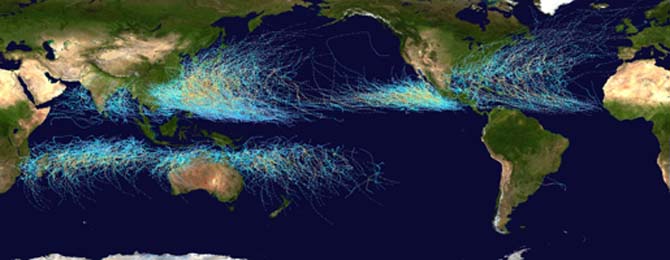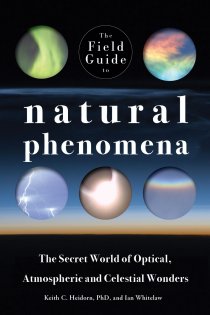 |
 |
| Home | Welcome | What's New | Site Map | Glossary | Accolades | Email Us |
 |
|
Tropical systems are ranked on one of several tropical cyclone scales according to what oceanic basin they are located in and their maximum sustained winds. Five scales of classifications are officially used by the meteorological agencies monitoring tropical cyclones in those specific regions designated by the World Meteorological Organization as a Regional Specialized Meteorological Centre (RSMC). |
 Global Distribution of Tropical Storms: |
|
A tropical cyclone formed in the North Atlantic Ocean or the Northeastern Pacific Ocean is classified using the Saffir-Simpson Hurricane Scale by the US National Hurricane Center. In the Western Pacific, tropical cyclones are ranked using the Japan Meteorological Agency's scale. The U.S. Joint Typhoon Warning Center (JTWC), the Philippine Atmospheric, Geophysical and Astronomical Services Administration (PAGASA), the China Meteorological Agency (CMA) and the Hong Kong Observatory (HKO) also monitor tropical cyclones in this basin and may use different ratings scales. The RSMC run by the Indian Meteorological Department in New Delhi, India uses its scale to assess tropical cyclones in the Northern Indian Ocean, particularly the Bay of Bengal and the Arabian Sea. Other warning centres that watch this region include RSMC La Reunion, the Bangladesh Meteorological Department and the United States Joint Typhoon Warning Center.The Mιtιo-France forecast center on La Reunion covers the Southwest Indian Ocean. Both the Australian Bureau of Meteorology and the RSMC in Nadi, Fiji use the Australian tropical cyclone intensity scale for storms in their jurisdictions in the South Indian Ocean and South Pacific Ocean. |
|
The definition of sustained winds recommended by the World Meteorological Organization (WMO), used by most weather agencies, is a 10-minute average measured at a height of 10 m (33 ft). There are exceptions. The Saffir-Simpson Hurricane Scale is based on wind speed measurements averaged over a 1-minute period, at 10 m (33 ft) above the surface. The scale used by RSMC New Delhi applies a 3-minute averaging period, and the Australian scale is based on both 3-second wind gusts and maximum sustained winds averaged over a 10-minute interval. |
Atlantic Ocean and East Pacific Ocean Basins |
SaffirSimpson Hurricane Wind Scale |
|
Category |
Wind Speeds |
| Five | ≥70 meter_per_second, ≥137 knots ≥157 mph, ≥252 km/h |
|---|---|
| Four | 5870 m/s, 113136 knots 130156 mph, 209251 km/h |
| Three | 5058 m/s, 96112 knots 111129 mph, 178208 km/h |
| Two | 4349 m/s, 8395 knots 96110 mph, 154177 km/h |
| One | 3342 m/s, 6482 knots 7495 mph, 119153 km/h |
Additional Classifications |
|
| Tropical storm |
1832 m/s, 3563 knots 3973 mph, 63118 km/h |
| Tropical depression |
<17 m/s, <34 knots <38 mph, <62 km/h |
Western Pacific Ocean Basin |
Tropical Cyclone Intensity Scale |
|
| Category | Sustained winds |
| Super Typhoon Category utilized only by U.S. Joint Typhoon Warning Center |
≥65 meter_per_second, ≥130 knots ≥157 mph, ≥252 km/h |
| Typhoon | ≥64 knot ≥118 km/h |
| Severe Tropical Storm |
4863 knot 89117 km/h |
| Tropical Storm | 3447 knot 6288 km/h |
| Tropical Depression |
≤33 knot ≤61 km/h |
North Indian Ocean Basin |
Tropical Cyclone Intensity Scale |
|
| Category | Sustained winds (3-min average) |
|---|---|
| Super Cyclonic Storm | >120 knot >222 km/h |
| Very Severe Cyclonic Storm |
64119 knot 118221 km/h |
| Severe Cyclonic Storm |
4863 knot 88117 km/h |
| Cyclonic Storm | 3447 knot 6287 km/h |
| Deep Depression | 2833 knot 5261 km/h |
| Depression | ≤27 knot ≤51 km/h |
Southwest Indian Ocean Basin |
Tropical Cyclone Intensity Scale |
|
| Category | Sustained winds |
|---|---|
| Very Intense Tropical Cyclone |
>115 knot >212 km/h |
| Intense Tropical Cyclone |
90115 knot 166212 km/h |
| Tropical Cyclone |
6489 knot 118165 km/h |
| Severe Tropical Storm |
4863 knot 89117 km/h |
| Moderate Tropical Storm |
3447 knot 6388 km/h |
| Tropical Depression |
2833 knot 5162 km/h |
| Tropical Disturbance |
<28 knot <50 km/h |
Australia and Fiji Basin |
Australian Tropical Cyclone Intensity Scale |
||
| Category | Sustained winds |
Gusts |
| Five | >107 knot >200 km/h |
>151 knot >279 km/h |
|---|---|---|
| Four | 86-107 knot 160-200 km/h |
122-151 knot 225-279 km/h |
| Three | 64-85 knot 118-159 km/h |
90-121 knot 165-224 km/h |
| Two | 48-63 knot 89-117 km/h |
68-89 knot 125-164 km/h |
| One | 34-47 knot 63-88 km/h |
49-67 knot 91-125 km/h |
| Tropical Low |
<34 knot <63 km/h |
<49 knot <91 km/h |
 |
Now AvailableThe Field Guide to Natural Phenomena: |
 |
To Purchase Notecard, |
Now Available! Order Today! | |
 |
 |
Now |
The BC Weather Book: |


